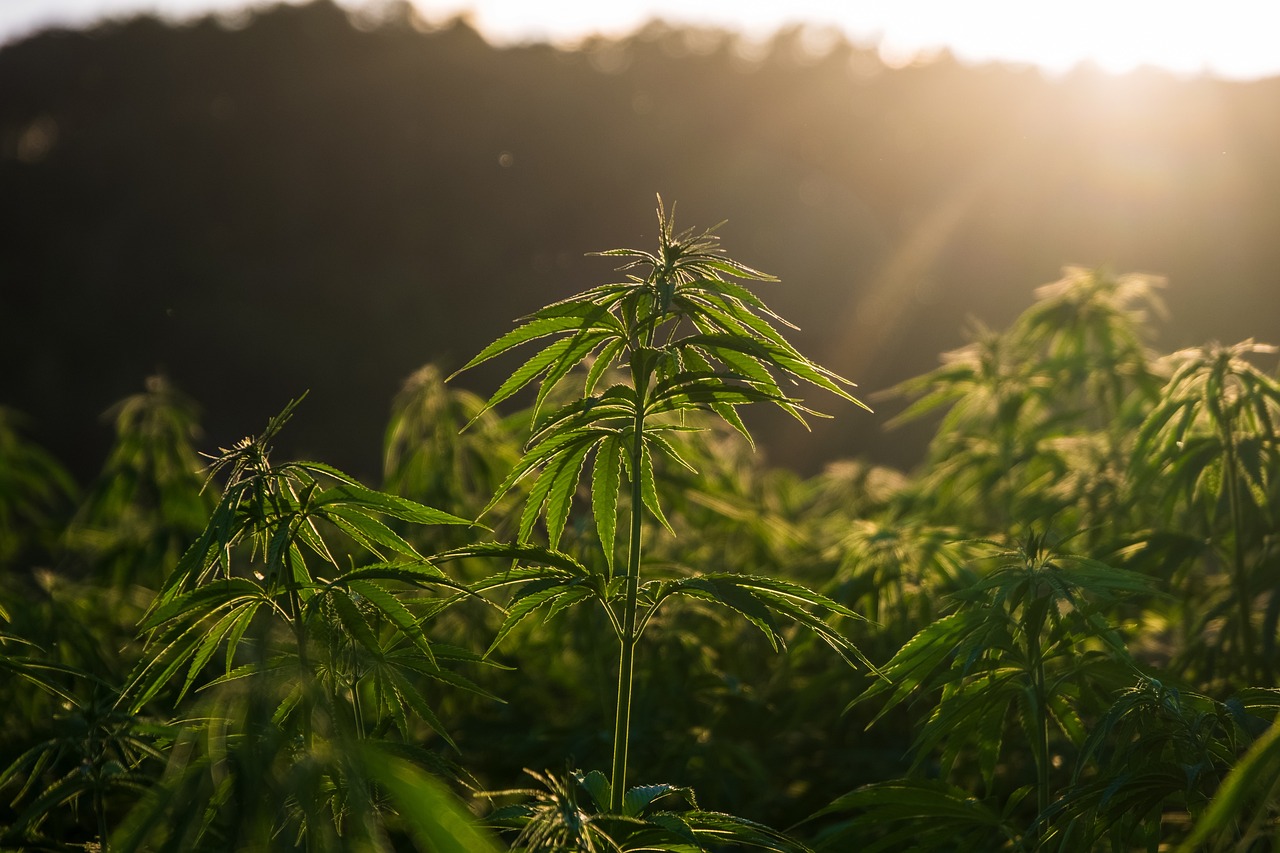
Cannabis, much like wine, owes much of its character and flavor profile to the environment in which it’s grown—a concept known as terroir. This term, borrowed from the wine industry, refers to the unique combination of soil, climate, and geography that influences the taste and quality of a plant. Understanding cannabis terroir can help consumers appreciate the diversity in flavors and effects, while growers can fine-tune their cultivation methods for superior results.
The Role of Soil
The soil in which cannabis is grown is one of the most significant factors influencing its terroir. Soil provides the essential nutrients that plants need to thrive, and different types of soil can impart distinct characteristics to the cannabis plant.
For instance, loamy soil, which is a balanced mix of sand, silt, and clay, is often praised for its ability to retain moisture while providing good drainage, leading to robust, flavorful plants. On the other hand, sandy soils, which drain quickly, can stress the plant, often resulting in more resin production and thus more potent flavors.
Soil composition also affects the plant’s access to micronutrients like zinc, copper, and manganese, which play crucial roles in developing the plant’s flavor and aroma. Organic soils rich in decomposed matter, like compost, can enhance the plant’s terpene profile, leading to more intense flavors and scents. These subtle variations create the diverse palate of flavors and aromas cannabis connoisseurs enjoy.
Climate and Geography
The climate where cannabis is grown also plays a crucial role in its development. Temperature, humidity, and sunlight exposure all contribute to the plant’s growth cycle and the expression of its chemical compounds. In warmer climates, cannabis plants may grow faster and produce larger buds, but the terpene profiles may differ from those grown in cooler environments, where plants might develop more complex flavors due to slower growth.Geography ties into this as well. Elevation can affect temperature and humidity levels, which in turn impacts the growth and resin production of the plants. For example, cannabis grown at higher altitudes may develop more robust flavors as the plant produces more resin to protect itself from the harsher conditions.
Conclusion
The terroir of cannabis is a fascinating and complex interplay of natural and human factors. By appreciating the influence of soil, climate, geography, and cultivation practices, consumers can better understand and enjoy the unique flavors of different cannabis strains. Whether you’re a grower or a consumer, exploring the terroir of cannabis opens up a world of discovery, offering a deeper connection to this remarkable plant.

![Let the raindrops keep falling, when you’ve got the powerful drops of Full Spectrum oil with you. With Awshad, you’ll not feel unusually low during the monsoon. Trust us, it’s just a phase.
awshadwellness #healing #health, green health, health and wellness ayurveda, care] #awshad](https://scontent-bom2-3.cdninstagram.com/v/t51.82787-15/525508389_18046782380556668_287620203980256963_n.webp?stp=dst-jpg_e35_tt6&_nc_cat=110&ccb=1-7&_nc_sid=18de74&_nc_ohc=wXYZUsc0EeMQ7kNvwF9mkzR&_nc_oc=Adl6-xSvafGtgi6cilSazKmogKqlMjTsUBA8I7985bVSvJ-mtClECIZfb62nOSTldczhuPWaJVeUgUi277ojSYvq&_nc_zt=23&_nc_ht=scontent-bom2-3.cdninstagram.com&edm=ANo9K5cEAAAA&_nc_gid=No7SvzmofF4sDqdWLuJf8A&oh=00_AfQKfF3YLu_ovH0pOwr3NIeQj55zMocAr5iCLAJIxko_cA&oe=688FF230)
![Let the raindrops keep falling, when you’ve got the powerful drops of Full Spectrum oil with you. With Awshad, you’ll not feel unusually low during the monsoon. Trust us, it’s just a phase.
awshadwellness #healing #health, green health, health and wellness ayurveda, care] #awshad](https://scontent-bom1-1.cdninstagram.com/v/t51.82787-15/524444118_18046782392556668_6430538198768718948_n.webp?stp=dst-jpg_e35_tt6&_nc_cat=104&ccb=1-7&_nc_sid=18de74&_nc_ohc=NG_bYVn-Z_EQ7kNvwGndVKF&_nc_oc=AdmlJdnr2mfg0fljsYd3a5kUOEyDlOQUv7rxIUhh8m0TRQGNM71eKOFiOZ4KChyhse3-lBIchO_amTkGL4ZEdjzC&_nc_zt=23&_nc_ht=scontent-bom1-1.cdninstagram.com&edm=ANo9K5cEAAAA&_nc_gid=No7SvzmofF4sDqdWLuJf8A&oh=00_AfTUWq1tpzKsOimagcesu9uvg8eCMMTb-dHoZMBOZa-cyw&oe=688FC16B)
![Let the raindrops keep falling, when you’ve got the powerful drops of Full Spectrum oil with you. With Awshad, you’ll not feel unusually low during the monsoon. Trust us, it’s just a phase.
awshadwellness #healing #health, green health, health and wellness ayurveda, care] #awshad](https://scontent-bom2-1.cdninstagram.com/v/t51.82787-15/525396270_18046782401556668_2173099860971820854_n.webp?stp=dst-jpg_e35_tt6&_nc_cat=108&ccb=1-7&_nc_sid=18de74&_nc_ohc=sBUrAQ88NjIQ7kNvwFA2SmU&_nc_oc=Adl8e4HBflmgEqg0Pqi79V154UlBRUNlR7QctglqAW4HozCMoyzDcnk_i8QeoE0TwmK4DivTWvS8tu3N6US9ouMr&_nc_zt=23&_nc_ht=scontent-bom2-1.cdninstagram.com&edm=ANo9K5cEAAAA&_nc_gid=No7SvzmofF4sDqdWLuJf8A&oh=00_AfT2iOqq7Ac1r_eGys_WzFRIuUcKZVnBkNi611udqBcZjQ&oe=688FD844)
![Feeling wired when you should be winding down? CBD may help calm your mind, ease tension, and support deeper, more restful sleep—naturally. So, breathe out the stress. Sleep better.
Save this post & share it with someone who needs rest tonight.
awshadwellness #healing #health, green health, health and wellness ayurveda, care] #awshad](https://scontent-bom2-1.cdninstagram.com/v/t51.82787-15/524417877_18046539332556668_6570912977729932125_n.webp?stp=dst-jpg_e35_tt6&_nc_cat=108&ccb=1-7&_nc_sid=18de74&_nc_ohc=jz_o5rNhIcQQ7kNvwGi7jOF&_nc_oc=AdlOC23utf-Pwz5CfgwJmcWm-3Ldeg0qxGM49NmkVdp62J4VX6pW0B-MDXGT2w8E55KFFXpoHrBEB3MTluMS1Hkj&_nc_zt=23&_nc_ht=scontent-bom2-1.cdninstagram.com&edm=ANo9K5cEAAAA&_nc_gid=No7SvzmofF4sDqdWLuJf8A&oh=00_AfRqwGxn6pwdLB8fjOw92VPN0yQNmyoFGPX0JV2gmIQ2Vw&oe=688FBE1C)
![Feeling wired when you should be winding down? CBD may help calm your mind, ease tension, and support deeper, more restful sleep—naturally. So, breathe out the stress. Sleep better.
Save this post & share it with someone who needs rest tonight.
awshadwellness #healing #health, green health, health and wellness ayurveda, care] #awshad](https://scontent-bom1-1.cdninstagram.com/v/t51.82787-15/525042452_18046539341556668_6684047278654212947_n.webp?stp=dst-jpg_e35_tt6&_nc_cat=104&ccb=1-7&_nc_sid=18de74&_nc_ohc=OBR2JHe3PzoQ7kNvwEphXNS&_nc_oc=Adk7GpmXG1s002IhP1PDF1GfqPAleLUU6ujDKx0s7aDiAv2wOp8HEXirtCnhzpJk_vTypXAyzL4GYWqLZIDj2N-M&_nc_zt=23&_nc_ht=scontent-bom1-1.cdninstagram.com&edm=ANo9K5cEAAAA&_nc_gid=No7SvzmofF4sDqdWLuJf8A&oh=00_AfSE-kLje7k9O6pU_Xkzs149a18YarpD2Wr-dRwPKyy3ow&oe=688FE1F4)
![Feeling wired when you should be winding down? CBD may help calm your mind, ease tension, and support deeper, more restful sleep—naturally. So, breathe out the stress. Sleep better.
Save this post & share it with someone who needs rest tonight.
awshadwellness #healing #health, green health, health and wellness ayurveda, care] #awshad](https://scontent-bom2-1.cdninstagram.com/v/t51.82787-15/524521320_18046539353556668_83173383789783640_n.webp?stp=dst-jpg_e35_tt6&_nc_cat=105&ccb=1-7&_nc_sid=18de74&_nc_ohc=pXuCeEnhn5EQ7kNvwHCn4Ps&_nc_oc=AdnhffI99bGwJscbYWdL41xiek6HWPkmwirYyL1mHq42DMP2jec_rcyMf4vtXbx_tLGHNgge47dFNxBqA8_ZO_-T&_nc_zt=23&_nc_ht=scontent-bom2-1.cdninstagram.com&edm=ANo9K5cEAAAA&_nc_gid=No7SvzmofF4sDqdWLuJf8A&oh=00_AfTug9J4uqaji26xvoAo1HlJIWC1U0TCR0cRlzEzoT45sg&oe=688FC4BE)
![Feeling wired when you should be winding down? CBD may help calm your mind, ease tension, and support deeper, more restful sleep—naturally. So, breathe out the stress. Sleep better.
Save this post & share it with someone who needs rest tonight.
awshadwellness #healing #health, green health, health and wellness ayurveda, care] #awshad](https://scontent-bom1-2.cdninstagram.com/v/t51.82787-15/525021332_18046539365556668_2541529019793570677_n.webp?stp=dst-jpg_e35_tt6&_nc_cat=109&ccb=1-7&_nc_sid=18de74&_nc_ohc=eBThXbKB-1YQ7kNvwFQtTry&_nc_oc=AdkTlXzDVxIroRDAdIlRh5ErqxGJ-gO4B4ovzk1LAaXN-qsql7CGj6aMvX7qy0OiMYV6XujfeGZLvj85Zg-xRplE&_nc_zt=23&_nc_ht=scontent-bom1-2.cdninstagram.com&edm=ANo9K5cEAAAA&_nc_gid=No7SvzmofF4sDqdWLuJf8A&oh=00_AfSP4dS3d1xejqeb70CBzEMSpTuoQL3y_HlISB0mXI6LBA&oe=688FD459)
![Feeling wired when you should be winding down? CBD may help calm your mind, ease tension, and support deeper, more restful sleep—naturally. So, breathe out the stress. Sleep better.
Save this post & share it with someone who needs rest tonight.
awshadwellness #healing #health, green health, health and wellness ayurveda, care] #awshad](https://scontent-bom2-3.cdninstagram.com/v/t51.82787-15/523948523_18046539374556668_8166387329337484893_n.webp?stp=dst-jpg_e35_tt6&_nc_cat=101&ccb=1-7&_nc_sid=18de74&_nc_ohc=jgig4AgPkhIQ7kNvwFT15R6&_nc_oc=AdlMNIFywF5l6AZ160tmhLJIrhA-T6xGvwyIHb11cLk86pURzcDrwNC0_OD88rirsTwb1qEPmq0PVfYCHkuJEw5t&_nc_zt=23&_nc_ht=scontent-bom2-3.cdninstagram.com&edm=ANo9K5cEAAAA&_nc_gid=No7SvzmofF4sDqdWLuJf8A&oh=00_AfR0iiX4FzWzVMD-ou_oI41FN92HIEeshsBDtS8umfnJ3A&oe=688FDF9A)
![It feels illegal but it’s legal, we promise. Check out our website for proof!
awshadwellness #healing #health, green health, health and wellness ayurveda, care] #awshad](https://awshad.com/wp-content/uploads/2022/06/523925340_18046184282556668_599732807729025438_n.jpg)
![Stress can wreak havoc on digestion—but CBD may help ease tension, calm the gut, and support a more balanced system. Take a breath. Trust your gut. Save this post & share it with someone who needs a reset from the inside out.
[ CBD, CBD products, wellness, health, wellness products, self care, all natural healing, happiness] #Awshad](https://scontent-bom1-2.cdninstagram.com/v/t51.82787-15/521975962_18045892904556668_2710068828576068354_n.webp?stp=dst-jpg_e35_tt6&_nc_cat=100&ccb=1-7&_nc_sid=18de74&_nc_ohc=aA6WSKJyhCEQ7kNvwG4MNsE&_nc_oc=Adk-b0zmcZ-A3hdoRG3PY0XxQgYWTH_OKCo51UwRMvmuUFJYuZmE07xdge5bXmb2h63zk6PDqZ_seExLHuxLtL0C&_nc_zt=23&_nc_ht=scontent-bom1-2.cdninstagram.com&edm=ANo9K5cEAAAA&_nc_gid=No7SvzmofF4sDqdWLuJf8A&oh=00_AfTPhblvrRUQKDWUSAYxW5U1OqumHx3OvYM_TF0GFsmh8w&oe=688FD1FB)
![Stress can wreak havoc on digestion—but CBD may help ease tension, calm the gut, and support a more balanced system. Take a breath. Trust your gut. Save this post & share it with someone who needs a reset from the inside out.
[ CBD, CBD products, wellness, health, wellness products, self care, all natural healing, happiness] #Awshad](https://scontent-bom2-3.cdninstagram.com/v/t51.82787-15/521446693_18045892913556668_1803768348628413488_n.webp?stp=dst-jpg_e35_tt6&_nc_cat=110&ccb=1-7&_nc_sid=18de74&_nc_ohc=WojvKeOnbOwQ7kNvwEeDjc3&_nc_oc=AdkhmJhM4M2lHhtNZi8j7RlxV8VDMsHBvhP_zx6E4tzh24PI2ZCc4Ahoiv_5N4qlEgz2b_isbgCB1goMI-8x0Cnw&_nc_zt=23&_nc_ht=scontent-bom2-3.cdninstagram.com&edm=ANo9K5cEAAAA&_nc_gid=No7SvzmofF4sDqdWLuJf8A&oh=00_AfTK82ylYwBSpYWcvy_mXAB0pMLWJH9RdsJArMmOKrRgGg&oe=688FE272)
![Stress can wreak havoc on digestion—but CBD may help ease tension, calm the gut, and support a more balanced system. Take a breath. Trust your gut. Save this post & share it with someone who needs a reset from the inside out.
[ CBD, CBD products, wellness, health, wellness products, self care, all natural healing, happiness] #Awshad](https://scontent-bom2-4.cdninstagram.com/v/t51.82787-15/521323232_18045892928556668_2225382532647044185_n.webp?stp=dst-jpg_e35_tt6&_nc_cat=102&ccb=1-7&_nc_sid=18de74&_nc_ohc=s8_TLS8W0dsQ7kNvwEVgKdL&_nc_oc=AdmwJYjBU62PB8v8jdzJaO6jCSlxTZrirL5O_voookkPuF2RD7bZAtEUTPPGWjIaEAjXPTT7h-IGySJoNFF6Zik3&_nc_zt=23&_nc_ht=scontent-bom2-4.cdninstagram.com&edm=ANo9K5cEAAAA&_nc_gid=No7SvzmofF4sDqdWLuJf8A&oh=00_AfRObBmsOJVN-EPLm94OV2a9nywhMOcY_NhUdEyCxkaSXA&oe=688FC812)
![Stress can wreak havoc on digestion—but CBD may help ease tension, calm the gut, and support a more balanced system. Take a breath. Trust your gut. Save this post & share it with someone who needs a reset from the inside out.
[ CBD, CBD products, wellness, health, wellness products, self care, all natural healing, happiness] #Awshad](https://scontent-bom2-4.cdninstagram.com/v/t51.82787-15/521861233_18045892937556668_2397297173940881240_n.webp?stp=dst-jpg_e35_tt6&_nc_cat=106&ccb=1-7&_nc_sid=18de74&_nc_ohc=18wTSUyxPvUQ7kNvwGO1jo7&_nc_oc=AdnBX-Shi-Qse-GSlMvx8RIpiAWLTh5PG82nYNwj14tD2Pbfmt5f7GCT_IwB1DgmlM7SNaMF7V4QrzdIX-cpJJXC&_nc_zt=23&_nc_ht=scontent-bom2-4.cdninstagram.com&edm=ANo9K5cEAAAA&_nc_gid=No7SvzmofF4sDqdWLuJf8A&oh=00_AfTv4CTe4cMC_Iu9rb7zSw5xZy99NDLwkmIuuF6RT5fIXg&oe=688FF481)
![Stress can wreak havoc on digestion—but CBD may help ease tension, calm the gut, and support a more balanced system. Take a breath. Trust your gut. Save this post & share it with someone who needs a reset from the inside out.
[ CBD, CBD products, wellness, health, wellness products, self care, all natural healing, happiness] #Awshad](https://scontent-bom2-3.cdninstagram.com/v/t51.82787-15/521296563_18045892949556668_2739174932365462674_n.webp?stp=dst-jpg_e35_tt6&_nc_cat=103&ccb=1-7&_nc_sid=18de74&_nc_ohc=YfP-HpOrllUQ7kNvwEpXQsq&_nc_oc=Adkyb4TFz0qDtrMgWc081haLJmJfSyVgZkqnS7iQE-RwdHAp_m9Ohz-QjbQGCeem6XgXZ5Goez-BQ0IAhQwhRLgu&_nc_zt=23&_nc_ht=scontent-bom2-3.cdninstagram.com&edm=ANo9K5cEAAAA&_nc_gid=No7SvzmofF4sDqdWLuJf8A&oh=00_AfTIlVD0ELyXKlmcB63RNQcLOEg9A4m9eJwBeHfqOR7VKA&oe=688FBFDE)